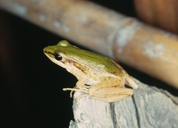|
Description
Rana taipehensis has a small, narrow body with a maximum SVL of 40 mm. This species is brightly colored. Dorsally it is yellowish green to greenish brown, with light yellowish brown sides. Paired dorsolateral glandular folds are present as brownish black lines. Front and hind limbs are light brown with dark brown stripes. The abdomen and neck bear tiny spots and have three brownish black stripes each. Slanted dark brown blotches are present at the anterior front. Anterior is white in background mixed with a gray dotted web pattern. The tympanic membrane and the region behind and below it are dark blackish brown in color (Lue 1990). Distribution and Habitat
Country distribution from AmphibiaWeb's database: Bangladesh, Bhutan, Cambodia, China, Hong Kong, India, Lao People's Democratic Republic, Myanmar, Taiwan, Thailand, Viet Nam
Rana taipehensis is limited to the northern parts of Taiwan, essentially confining the population to Taipei (Lue 1999). Previously, it was present in large numbers in the valleys, but is now rarely seen in the southern parts of Taiwan (Lue 1990). However, this frog is widespread in other parts of Asia, including Bangladesh, Cambodia (Stuart et al. 2006), China (Yang 2008), Hong Kong, Lao People's Democratic Republic (Stuart 2005), Myanmar (Wogan et al. 2008), Thailand (Chan-ard 2003), and Viet Nam (Orlov et al. 2002; Nguyen et al. 2005). It may also be present in Peninsular Malaysia but has not yet been recorded there (Van Dijk et al. 2004). Rana taipehensis populates areas from lowlands up to 800 m above sea level (Van Dijk et al. 2004). This species can be found in wet, damp crop fields, ponds, and hills with tea crop plants present (Lue 1990), as well as open grassy wetlands, rice paddies, river floodplains, and swamps in deciduous forests (Van Dijk et al. 2004). Life History, Abundance, Activity, and Special Behaviors
They are found in dense tree masses in groups during the daytime (Lue 1990). Breeding occurs in standing water with thick vegetation at water's edge (Van Dijk et al. 2004).
In areas with increased urbanization (and increased ambient noise), Rana taipehensis have been observed to call at a faster rate. It is not known whether this change in call rate interferes with calls of other species (Sun and Narins 2004). Trends and Threats
The population is currently stable (Van Dijk et al. 2004). It can adapt to a variety of habitats, including agricultural ones (Van Dijk et al. 2004). However, despite its classification as Least Concern, the species is becoming more sensitive to any outside stresses in endangered regions, such as Taiwan (Lue 1990). It is known to occur within several protected areas (Van Dijk et al. 2004). Relation to Humans
In some parts of the world, Rana taipehensis is treated as a pest and is eliminated (Lue 1990). In addition, pollution from insecticides presents a threat (Lin et al. 2008). Possible reasons for amphibian decline Local pesticides, fertilizers, and pollutants
Comments
The status of this species in India is controversial; Frost notes in Amphibian Species of the World that this species has been confused with Rana erythraea and Rana tytleri.
References
Chan-ard, T. (2003). A Photographic Guide to Amphibians in Thailand. Krangkrai Swannapak, Bangkok.
Chou, W. H. (2003). ''Tadpole and call of Rana taipehensis in Taiwan.'' Bulletin of National Museum of Natural Science, 4, 77-86.
Chou, W. H., Chang, H. W., and Lue, K. Y. (1993). ''Notes on distribution of the frog Rana taipehensis in Taiwan.'' Bulletin of National Museum of Natural Science, 4, 183-186.
Dijk, P. P., Stuart B., Lau M., Chan, B., Yuan, Z., Lue K., Chou, W., Dutta, S., Sengupta, S., Ohler, A., Bordoloi, S., and Asmat, G. 2004. Hylarana taipehensis. In: IUCN 2008. 2008 IUCN Red List of Threatened Species. www.iucnredlist.org. Downloaded on 05 May 2009.
Lin, H.-C. , Cheng, L.-Y., Chen, P.-C., and Chang, M.-H. (2008). ''Involving local communities in amphibian conservation: Taipei frog Rana taipehensis as an example.'' International Zoo Yearbook, 42(1), 90-98.
Lue, K.-Y. (1990). The Amphibians and Reptiles of Taiwan. The Council of Agriculture, Taiwan. R.O.C.
Lue, K.-Y., Tu, M.-C., and Hsiang, K.-S. (1999). Atlas of Taiwan Amphibians and Reptiles. Nature Press, Taipei.
Nguyen, V. S., Ho, C. T., and Nguyen, T. Q. (2005). A Checklist of the Amphibians and Reptiles of Vietnam. Nha Xuat Ban Nong Nghiep, Hanoi, Vietnam.
Orlov, N. L., Murphy, R. W., Ananjeva, N. B., Ryabov, S. A., and Ho, T. C. (2002). ''Herpetofauna of Vietnam, a checklist. Part 1. Amphibia.'' Russian Journal of Herpetology, 9, 81-104.
Stuart, B. L. (2005). ''New frog records from Laos.'' Herpetological Review, 36, 473-479.
Stuart, B. L., Sok, K., and Neang, T. (2006). ''A collection of amphibians and reptiles from hilly eastern Cambodia.'' Raffles Bulletin of Zoology, 54, 129-155.
Sun, J. W. C., and Narins, P. M. (2004). ''Anthropogenic sounds differentially affect amphibian call rate.'' Biological Conservation, 121, 419-427.
Yang, D. and Rao, D. (2008). Amphibia and Reptilia of Yunnan. Yunnan Publishing Group Corporation, Kunming.
Originally submitted by: Jesse Lou (first posted 2000-08-09)
Edited by: Kellie Whittaker (2010-05-05)Species Account Citation: AmphibiaWeb 2010 Hylarana taipehensis: Taipei frog <https://amphibiaweb.org/species/5164> University of California, Berkeley, CA, USA. Accessed Apr 19, 2024.
Feedback or comments about this page.
Citation: AmphibiaWeb. 2024. <https://amphibiaweb.org> University of California, Berkeley, CA, USA. Accessed 19 Apr 2024.
AmphibiaWeb's policy on data use.
|
